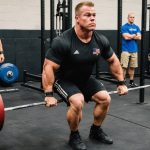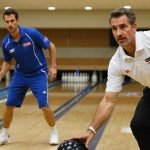Top Strength Training Workouts for Elite Lugers: Unlock Your Athletic Potential
Understanding the Demands of Luge
Luge, a high-speed winter sport that involves navigating an ice track on a small sled, requires a unique blend of strength, speed, and precision. Elite lugers must possess a combination of powerful muscles, exceptional reaction time, and the ability to maintain focus under intense pressure. To achieve this level of performance, a well-structured strength training program is essential.
Physical Requirements
Luge athletes need to develop specific physical attributes, including:
This might interest you : Unlocking Indoor Cricket Success: Essential Strategies for Mastering Tactical Gameplay
- Muscular Strength: Particularly in the upper body, core, and legs to handle the forces generated during the start and the turns on the track.
- Power: The ability to generate rapid, powerful movements to accelerate the sled.
- Endurance: To maintain performance over the duration of the race.
- Flexibility: To maintain optimal body positioning on the sled.
Building a Strength Training Program
A comprehensive strength training program for elite lugers should be tailored to address these specific physical requirements.
Periodization
Periodization is a key concept in strength training, involving the systematic planning of training phases to achieve peak performance at the right time. For lugers, this typically includes:
Also read : Mastering Middle-Distance: Top Pacing Strategies for Race Day Success
- Off-Season: Focus on building overall strength and muscle mass through exercises like squats, deadlifts, bench press, and rows.
- Pre-Season: Transition to more specific strength training that mimics the movements and forces encountered in luge, such as sled pushes and resisted sprints.
- In-Season: Maintain strength while focusing on power and speed work, including plyometric exercises and short sprints.
Core Exercises for Lugers
Here are some core exercises that are crucial for elite lugers:
Upper Body Strength
- Bench Press: Develops chest, shoulder, and tricep strength.
- Sets and Reps: 3-4 sets of 8-12 reps.
- Pull-Ups: Targets back and arm muscles.
- Sets and Reps: 3-4 sets of as many reps as possible.
- Dumbbell Rows: Enhances back and arm strength.
- Sets and Reps: 3-4 sets of 8-12 reps.
Lower Body Strength
- Squats: Builds leg and core strength.
- Sets and Reps: 3-4 sets of 8-12 reps.
- Deadlifts: Develops overall lower body and back strength.
- Sets and Reps: 3-4 sets of 8-12 reps.
- Lunges: Targets leg strength and balance.
- Sets and Reps: 3-4 sets of 8-12 reps per leg.
Core Strength
- Planks: Enhances core stability and endurance.
- Sets and Reps: 3-4 sets of 30-60 seconds.
- Russian Twists: Targets oblique muscles.
- Sets and Reps: 3-4 sets of 12-15 reps per side.
- Leg Raises: Develops lower core strength.
- Sets and Reps: 3-4 sets of 12-15 reps.
Power and Speed Training
In addition to strength training, elite lugers need to focus on developing power and speed.
Plyometric Exercises
- Box Jumps: Improves explosive power.
- Sets and Reps: 3-4 sets of 8-12 reps.
- Medicine Ball Throws: Enhances upper body power.
- Sets and Reps: 3-4 sets of 8-12 reps.
- Resistance Band Sprints: Mimics the acceleration phase of luge.
- Sets and Reps: 3-4 sets of 20-30 yards.
Nutrition and Recovery
Proper nutrition and recovery are critical components of any strength training program.
Nutritional Considerations
- Protein Intake: Essential for muscle repair and growth. Aim for 1.2-1.6 grams of protein per kilogram of body weight.
- Carbohydrates: Provides energy for workouts. Focus on complex carbs like whole grains, fruits, and vegetables.
- Healthy Fats: Supports overall health and hormone production. Include sources like nuts, seeds, and avocados.
Recovery Techniques
- Rest and Sleep: Adequate rest is crucial for muscle recovery. Aim for 7-9 hours of sleep per night.
- Stretching and Foam Rolling: Helps in reducing muscle soreness and improving flexibility.
- Ice Baths and Compression Garments: Can aid in reducing inflammation and enhancing recovery.
Mental Preparation
Mental toughness is as important as physical strength in luge.
Visualization Techniques
- Mental Rehearsal: Visualize yourself performing perfectly on the track. This can help in building confidence and reducing anxiety.
- Positive Self-Talk: Maintain a positive mindset through affirmations and self-encouragement.
Stress Management
- Breathing Exercises: Techniques like deep breathing can help in managing stress and staying focused.
- Team Support: Having a supportive team and coaches can significantly impact mental well-being and performance.
Case Study: Elite Luger Training Program
Here is an example of a weekly training program for an elite luger:
| Day | Morning Session | Afternoon Session |
|---|---|---|
| Monday | Strength Training (Upper Body) | Power Training (Plyometrics) |
| Tuesday | Strength Training (Lower Body) | Speed Training (Sprints) |
| Wednesday | Rest Day | Active Recovery (Light Yoga or Cycling) |
| Thursday | Strength Training (Core) | Power Training (Resistance Band Sprints) |
| Friday | Strength Training (Full Body) | Speed Training (Hill Sprints) |
| Saturday | Rest Day | Active Recovery (Light Swimming or Walking) |
| Sunday | Long Slow Distance (LSD) Training | Mental Preparation and Visualization |
Expert Insights
“Strength training is not just about lifting weights; it’s about building the resilience and power needed to perform at the highest level,” says Dr. Nitin Jain, a renowned expert in human performance and sports medicine. “For elite lugers, it’s crucial to tailor the training program to the specific demands of the sport, including the need for explosive power and endurance.”
Unlocking your athletic potential as an elite luger requires a holistic approach that includes a well-structured strength training program, proper nutrition, effective recovery techniques, and mental preparation. By focusing on these key areas and staying committed to your training, you can achieve the performance levels necessary to succeed in this demanding and exhilarating sport.
Practical Advice for Aspiring Lugers
- Start Early: Begin strength training and power work early in your career to build a strong foundation.
- Seek Professional Guidance: Work with experienced coaches and trainers who understand the specific needs of luge athletes.
- Stay Consistent: Consistency is key in any training program. Stick to your plan and make adjustments based on feedback and performance.
- Incorporate Sport-Specific Training: Include exercises and drills that mimic the movements and forces encountered in luge to enhance your performance.
By following these guidelines and staying dedicated to your training, you can maximize your potential and achieve success in the high-speed world of luge.













